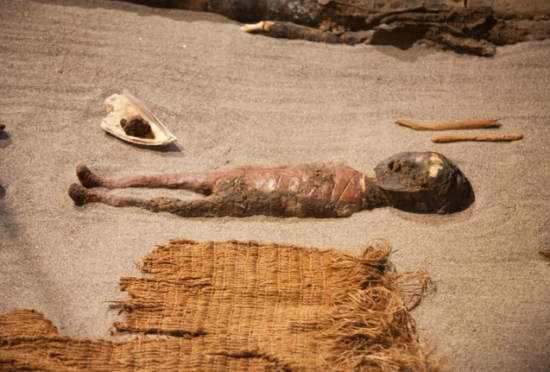Kristina Killgrove
Source - https://www.forbes.com/sites/kristinakillgrove/2018/01/26/ancient-baby-teeth-tell-archaeologists-that-life-in-this-south-american-desert-was-stressful/#1bec61b3770b
 Chinchorro Mummy Of A Baby On Display At The San Miguel De Azapa Archaeological Museum, Arica And Parinacota Region, Chile (Photo by: Insights/UIG via Getty Images)
Chinchorro Mummy Of A Baby On Display At The San Miguel De Azapa Archaeological Museum, Arica And Parinacota Region, Chile (Photo by: Insights/UIG via Getty Images)
A new study by an international team of archaeologists demonstrates how baby teeth can reveal patterns of physiological stress for both the in utero fetuses and their mothers. Focusing on a series of sites in the Atacama Desert of northern Chile, the study uses chemical testing of the deciduous teeth to investigate what mothers were eating while pregnant and what potential diseases they had.
Writing in the American Journal of Physical Anthropology this month, a team of researchers led by Charlotte King of the University of Otago in New Zealand studied teeth from 30 kids dating to the pre-agricultural (4000-1700 BC) or Chinchorro and agricultural (1700 BC - 450 AD) periods of the Atacama region, which includes the hottest, driest desert in the world. Rainfall is minimal, which complicates crop-growing, but the coastal location meant an abundance of marine food resources.
The researchers' goal was to investigate patterns in breastfeeding and weaning in young children in this culture. To accomplish this, they tested baby teeth, which begin to be formed in utero, for the isotopes of carbon and nitrogen. We incorporate carbon into our bodies through the plants we eat, and nitrogen through eating proteins like beans or meat, so variants of these elements reveal what we have eaten over time.
King and her colleagues found high nitrogen values in many of the baby teeth, which could "reflect the marine-resource consumption of mothers in these coastal sites," they write. A prenatal diet high in seafood would transfer high nitrogen values to their growing babies.
Another possibility, though, for the high nitrogen values is maternal stress. Because many of the infants showed a decrease in nitrogen values around the time of birth, King and colleagues suggest that this may relate to "changes to postnatal physiologial stress levels as the infant is removed from the stressful in utero environment." For example, if the mother was eating a diet too low in protein or calories, her body would start consuming its fat reserves, causing her nitrogen isotope ratio to go up. If she suffered from a condition like hyperemesis gravidarum (severe morning sickness), dietary isotope values would change as well.
Scurvy (vitamin C deficiency) was common in this ancient population as well, and that could be passed on to the growing fetus. "This suggests that the prehistoric populations of the Atacama were subject to periodic episodes of resource insecurity and associated micronutrient deficiencies," the researchers conclude.
A related study in the Azapa Valley of Chile of mummified females provides additional support for the theory of prenatal stress. That analysis "highlighted the presence of fetal or placental remains still within the uterus in 18% of young females," which suggests that "complications during or just after childbirth were relatively common and often resulted in maternal death" in this time period, King and colleagues note.
In spite of the often deadly outcomes of pregnancy and childbirth, the ancient populations that lived in the Atacama Desert flourished for millennia, showing that humans are resilient even in the toughest conditions.